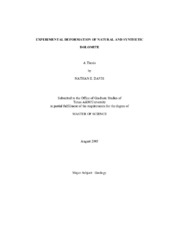| dc.description.abstract | Natural and hot isostatically pressed dolomite aggregates were experimentally deformed at effective pressures of Pe = 50 ?? 400 MPa, temperatures of 400 ?? 850??C, and strain rates of ε& = 1.2x10-4 s-1 to 1.2x10-7 s-1. Coarse- and fine-grained dolomite deformed at low temperature (T ≤ 700??C for coarse-grained natural dolomite, T < 700??C for fine-grained natural and synthetic dolomite) exhibit mechanical behavior that is nearly plastic; differential stresses are insensitive to strain rate, fitted either by a power law no⎟⎟⎠⎞⎜⎜⎝⎛−=??σσεε31&& with n values that range from 12 to 49 or an exponential law ([31exp )] σσαεε−=o&& with exponential law term α values from 0.023 to 0.079 MPa-1. Microstructures of samples deformed at low temperatures include mechanical twins, and undulatory extinction suggesting that twin glide and dislocation slip are the predominant deformation mechanisms. At high temperatures (T ≥ 800??C) flow strengths of coarse- and fine-grained dolomite depend more strongly on strain-rate and exhibit pronounced temperature dependencies. Microstructures of coarse-grained dolomite samples deformed at T ≥ 800??C include undulatory extinction and fine recrystallized grains suggesting that recovery and dynamic recrystallization contribute to dislocation creep at these conditions. By comparison with lower temperature deformation, mechanical twinning is unimportant. Fine-grained synthetic dolomite deformed at high temperature (T ≥ 700??C) exhibits nearly linear (Newtonian) viscous behavior, with n = 1.28 (??0.15) consistent with grain boundary (Coble) diffusion creep. At low temperatures (T ≤ 700??C) coarse-grained dolomite exhibits higher strengths at higher temperatures which cannot be described by an Arrhenius relation, while fine-grained dolomite strengths show little or no temperature dependence. At high temperatures (T ≥ 800??C), dislocation creep of coarse-grained dolomite can be described by a thermally activated power law ⎟⎟⎠⎞⎜⎜⎝⎛−⎟⎟⎠⎞⎜⎜⎝⎛−=RTHno*31exp??σσεε&& with H*/n = 60 kJ/mol, or by an exponential law ()[]⎟⎟⎠⎞⎜⎜⎝⎛−−=RTHo*31expexpσσαεε&& with H*/α = 25447 kJ/mol. At high temperatures, diffusion creep of fine-grained synthetic dolomite can be described by ⎟⎟⎠⎞⎜⎜⎝⎛−⎟⎟⎠⎞⎜⎜⎝⎛−⎟⎠⎞⎜⎝⎛Ω=RTHdno*313exp??σσεε&& with H* = 280 ??45 kJ/mol. Taken together, the flow laws for coarse- and fine-grained dolomites constrain the high temperature conditions over which crystal plasticity, dislocation creep, and diffusion creep dominate. | en |


